By Kathy Leahy
I could hardly believe my eyes when I saw that little fish swimming in a ten-gallon tank in my St. Louis, Missouri home. It was a juvenile fish I had raised from a collection of freshly hatched larvae, a gift from my friend Tom Priscu. On that July day in 2016, it had grown to acquire its adult coloration with rich purple-blue on the tail, fins and body outline, and with orange in the center. It was one of my three surviving Centropyge bispinosa juveniles, and its change in appearance to adult coloration was a milestone that marked significant progress in the hobby. Unlike freshwater aquarium fish, little is known about how to raise the majority of marine ornamentals. In particular, the genus Centropyge had never been raised to adult coloration, so far from plankton-rich oceans and well-supported aquaculture laboratories, and never by a hobbyist. The bispinosa species had never been raised by anyone, anywhere, at all. My little fish was undeniably settled, colored-up, and beautiful. It was something stunning, and truly new. I snapped a picture, and rushed to my day job with my mind in a fog.

Centropyge bispinosa. Photo by Gary Parr.
It has been fifteen years since Frank Baensch closed the life cycle for the Fisher’s Angelfish (Centropyge fisheri) in his lab on Oahu, in 2001. His was the first successful effort to raise a Centropyge genus fish ever, and he did it from start to finish, including capturing both the brood stock and the first live prey food items from the ocean around Hawaii. Since then he has raised many Centropyge species, including some hybrids. Soon after this initial success, in 2002, Laidley, Callan, and Sheilds, raised C. loricula in captivity at the Oceanic institute in Hawaii. Dale Sarver and Neil Sims, of Black Pearls, Inc., a division of Kona Blue Water Farms, successfully raised commercial numbers of C. loricula. Independently, Syd Kraul, of Pacific Planktonics, raised C. loricula and C. multicolor. Also in 2002, Karen Brittain raised Genicanthus personatus at the Waikiki Aquarium, and in 2013-2014 raised C. venusta and C. acanthops with funding from Rising Tide. I heard that in 2008, Kevin Lappeman raised about 10 C. flavissimus in the UK, but I can find nothing written about it, and I have not been successful in contacting him. Wen-Ping Su at Bali Aquarich, a large facility located in Indonesia, raised C. flavissimus in 2015. And, hot on my heels in 2016, Tom Bowling of Biota Marine Life Nursery is culturing commercial numbers of C. bispinosa using plankton from the ocean around Palau as first feeds. Aside from Lappeman’s, all Centropyge successes are noted to have come from islands around the major oceans, and no one in the lower 48 states has been successful until now.
The advantages of living by the ocean are many, and several of these breeders, working independently of each other, used water, either from a saltwater well or the ocean, in their tanks. They found their brood stock by fishing for them, and obtained nutritious first foods by skimming the ocean surface with plankton nets, and in some cases, culturing selected copepod species. From reading about their ventures, one could only assume that enormous tanks, copious volumes of natural water, and feeding resources I could not imagine squeezing into my little basement, were required. Perhaps the difficulties experienced by those early pioneers of marine angelfish breeding discouraged some who might have attempted it, or perhaps it was the scale of seemingly necessary equipment, or a lack of matching resources, but raising angelfish continued to be a dream for the landlocked fish breeders for over 15 years.
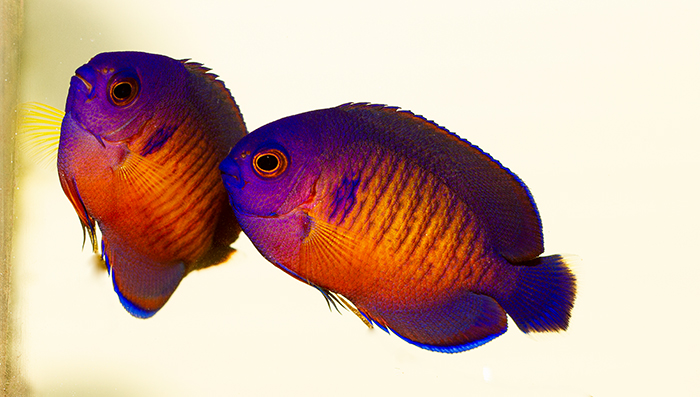
Centropyge bispinosa. Photo by Gary Parr.
I started raising Amphiprion ocellaris, orange clownfish around 2005, with eggs donated by Brad Witte, a kind friend and local hobbyist. Soon my own clownfish were spawning, and I set up a few 20-gallon grow-out tanks in my basement, and started selling orange and black fish to the local and not so local aquarium stores around St. Louis. After many years of doing this, I grew weary of the same breeding regimen, and started to try to raise other kinds of ornamental fish. I thought it would be reasonable to start with the smaller species, and for many of those, larval mouth size prohibited the use of rotifers as a first food. Copepods would be required for some species, and would promote success even with species that do not require them, so I began to try to master copepod culture. I quickly learned that part of that mastery would require returning to phytoplankton culture, which I had done as a part of the early years of clownfish breeding. Copepods of all types thrive on live phytoplankton. I had some limited success raising the cleaner gobies Elacantinus oceanops, and evelynae, Watchman gobies Cryptocentrus cinctus, the Coral goby Gobiosoma okinawae, and also peppermint shrimp Lysmatta boggessi, and the damsel Dascyllus aruanus. It was fun, I failed a lot, succeeded occasionally, and kept trying.

Photo by Gary Parr.
Meanwhile, my then-acquaintance Tom Priscu, encountered me at my local fish store and let me know that he had dragonets, mandarins, and angelfish spawning in his enormous tanks at his house. Would I like the eggs? Well, of course, I would be delighted to try to raise those eggs! He began delivering them to me in little jars and zip-lock bags when he was in town. Sometimes I met him at his gym, where he, and his young family were members. Sometimes he would drive his young family to my house for a delivery. I compensated by sharing my plankton cultures and helping him get them started. I think I had the better part of the deal. His lovely wife and three adorable little girls were very patient with our long and technical conversations. I continue to be most grateful for the ongoing gifts of eggs. As time went by, we improved our egg transport methods, from leaky plastic jars in cardboard boxes to air and water filled zip-lock bags in Styrofoam coolers to maintain temperature. I began to be able to hatch the eggs reliably. But mostly, they hatched on their own.
All of Tom’s spawning fish are pelagic spawners, meaning they release their gametes in open water when they spawn and the fertilized eggs either float or are suspended close to the surface of the tank. Tom sucks them off the surface water of his large tanks using a turkey baster, which is a kitchen tool resembling a giant transfer pipet. He squirts the captured eggs and water into a zip-lock bag, and floats it in his tank, to control temperature, until the eggs hatch, or he needs to transport them to me. Conventional wisdom says that the eggs of pelagic spawners are tremendously delicate, but we have not found that to be true. Our casual handling of them and transporting them did not appear to do any damage.
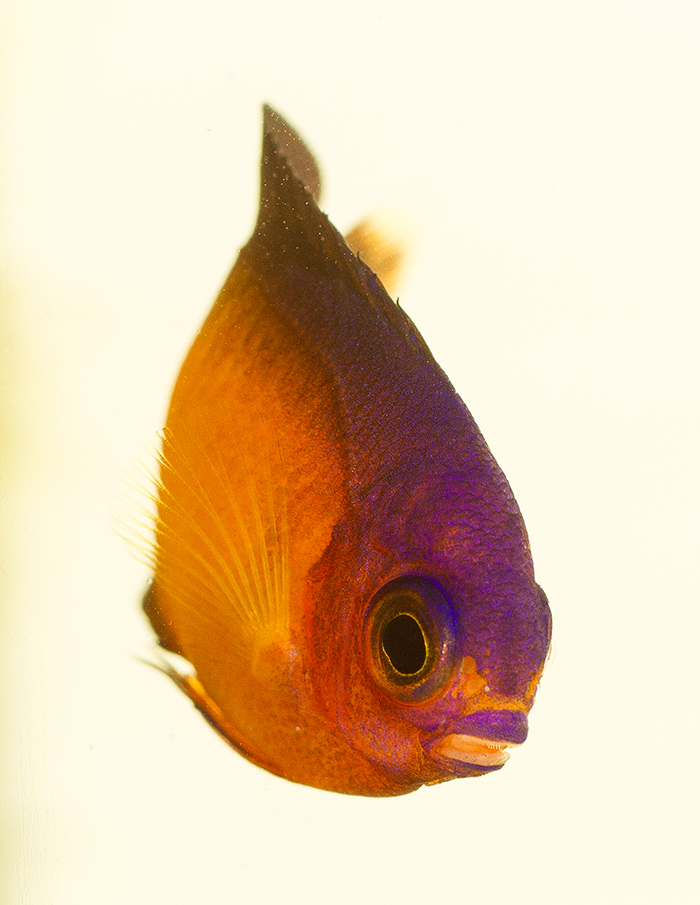
Centropyge bispinosa. Photo by Gary Parr.
Most of the pelagic spawners’ eggs hatch within a day of being spawned. They hatch as pro-larvae, meaning that they are not yet ready to feed on prey, but rely on their yolk sac to fuel their development. Indeed, they have a lot of development to do. At hatch, both angelfish and dragonets have no usable gut or mouth, and their eyes are underdeveloped and lack pigment. Within a few days, given the right conditions, all these amazing developmental feats are completed and the larvae are ready to hunt and eat live prey. Yet the larvae are so tiny that only the first stage nauplii of the smallest pelagic calanoid copepod will do as a first food. Enter Parvocalanus crassirostris, a ubiquitous calanoid, found in both the Atlantic and the Pacific, and also, thankfully, on the product lists of Reed Mariculture and AlgaGen. We do not have to live near an ocean to get our starter of Parvo., we can just order some, and culture our own first feeds. As a landlocked fish breeder, I think of this as a distinct advantage.
Our first batches of angelfish eggs did not do well, did not hatch, or did not thrive. I focused on the eggs that did survive–the dragonets. Tom and I both worked with eggs from his Ruby Red Synchiropus sycorax., a recently discovered and popular “scooter, blenny”, and I continued to try raising gobies, damsels, and shrimps as well. I could routinely get any larvae past starvation day on the Parvocalanus copepods, but sometimes larvae seemed to die a couple of days or weeks later, starving, it seemed, in a dense culture of these prolific, nutritious, live prey items. I didn’t understand it. (Looking back, I think that some of the dragonet runs didn’t die, but settled, and I didn’t expect it or know the signs. Synchiropus species, I’ve later learned, look like detritus when they settle, and barely move, so I could easily have overlooked them. ) But why did goby larvae die, when there were tons of adult copepods, an amazing number of them? I once counted 80 adults per milliliter! Surely they would be populating the tank with tons of eggs and nauplii, small enough for young larvae to gorge on.
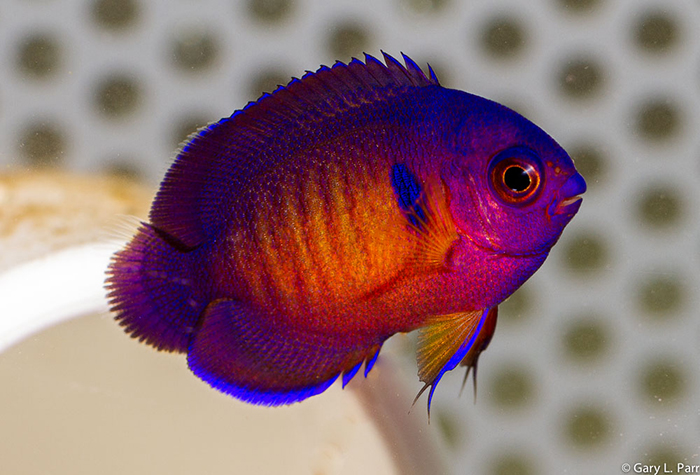
Centropyge bispinosa. Photo by Gary Parr.
One of the advantages of my work at Washington University Medical School in St. Louis is the amazing access we have, right at our computers, of all the library holdings. I can do searches when I have a question that may be addressed by a published article, and it was during one of these searches that I found a study by Dean Kline and Charles Laidley, colleagues of Chad Callan at the Oceanic Institute, on intensive copepod culture of Parvocalanus crassirostris, the very copepod I was using. In it, the authors describe just the phenomenon that was causing my larval deaths. When adult copepods are crowded beyond 4 per ml, they stop breeding. My 80 adult/ml culture was making NO new nauplii, and that is probably why every fish larva, needing prey smaller than the adults, starved! Wow! The good news, I learned, is that if one cultures the population of adult copepods below 4 /ml, and removes the resulting eggs and nauplii daily, the adults will continue to produce more, for weeks on end. For feeding tiny larvae, this is the best news of all. It was now possible to feed my larvae fresh, early stage nauplii every day for the price of feeding the copepod culture, keeping the adult numbers within parameters, and harvesting daily. I started feeding all my young, exogenously feeding larvae the new nauplii each day, and all my cultures did better, and all the larvae lived longer.
During the time I was struggling with feeding tiny larvae, I read a forum post about Ramon Villaverde from landlocked Ohio, whose job was to care for the aquariums at the Columbus Zoo. His aquarium was a member of the wonderful Rising Tide organization, a cooperative of public aquariums and fish breeding organizations. Before Rising Tide, the well-cared-for fish in public aquariums would frequently spawn, but the eggs were never collected for raising them, as the spawning events would happen after hours, and the staff had not been trained to readily culture the products. With the cooperative agreement and funding by Rising Tide, skimmers were built and put in place to collect the floating eggs of pelagic spawners in the great tanks of public aquariums, eggs could be collected the next morning, and either shipped to fish breeders connected to Rising Tide, or cultured in house by lucky staff trained by Andrew Rhyne.
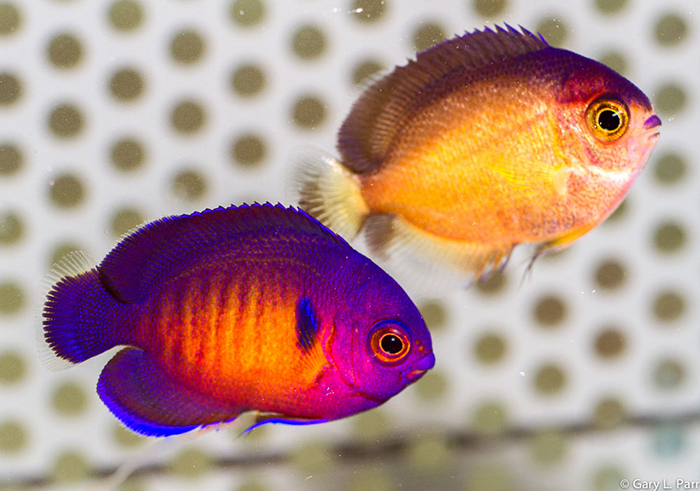
Centropyge bispinosa. Photo by Gary Parr.
Andy recently led workshops at his fish breeding lab at Roger Williams University, Rhode Island, to teach public aquaria participants a method of raising larvae and to provide a starter kit to take home, so they could use cutting edge materials at their respective work places to raise the eggs they could collect, themselves. Villaverde was one such lucky staff member. He collected and shipped eggs, but even before Andy’s course began, also attempted to culture the leftover eggs, on his own, in found space at his workplace. He used excess Paracentropyge spp. eggs from his own exhibit, and raised them in 6-liter pretzel jars, recycled from snacks offered to visiting groups of children, rather than the giant tubs usually associated with this kind of fish rearing. It was a groundbreaking achievement, and proved that large vats were not a requirement to raise the larvae of pelagic spawners. As I have quite limited space in my home fish-breeding basement, I began to collect pretzel jars. If Ramon can raise large angels in 6 liters, I should be able to raise small ones in a similar small volume of water.
Using the hint that pretzel jars can be appropriate to raising pelagic larvae, I began my quest to raise angelfish by putting some of Tom’s Centropyge eggs in a jar, and seeing what might happen. Actually, Tom gave me some Synchiropus sycorax Ruby Red Scooter eggs at the same time, and I was actually focusing on them, in a separate jar, with little hope that the angel larvae would survive. Previously, I had achieved some success getting Ruby Reds to live well beyond their starvation day, to grow and to seemingly thrive in the pretzel jar. It was great to be able to see them doing it, just by looking through the sides of the jar, illuminating my vision with a flashlight. One can learn a lot just by observation, and the pretzel jar was a great facilitator to this learning. Surprisingly, and despite my casual care of them, the Centropyge eggs hatched in the pretzel jar, some larvae survived in my care, and one little guy made it to 19 days. I was utterly shocked, because it was not supposed to be possible!
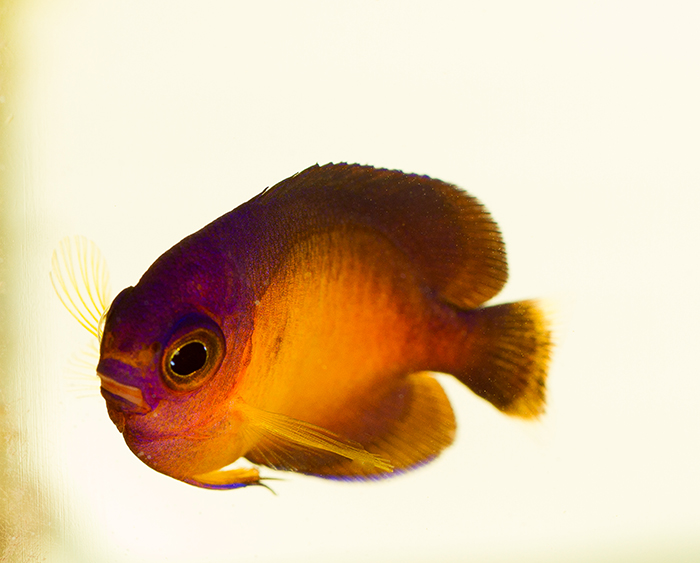
Centropyge bispinosa. Photo by Gary Parr.
For the next opportunity at angelfish eggs, I could feel the closeness of the dream, and thought I should take a more serious approach. I put the eggs in 17 gallon black round tub, really a muck bucket, but the closest approximation I had to Andy’s cutting edge equipment, and gave it my best shot with some revisions in protocol.
Ramon had posted on a forum that he used much more phytoplankton to darken his larval rearing water than I had typically used. I was thinking about this information when I was given access to the abstract of a potential speaker at the MBI 2016 workshop. Erin Perriera-Davison was a student of Chad Callan at the Oceanic Institute, and had worked on optimizing environmental factors around first feeding of Yellow Tangs, a species-first raised by the Callan lab in the past year. She shared actual data from experiments she did to discover optimum values of turbidity, temperature, and light, among other interesting parameters. One could draw from her experiments that more darkening with phytoplankton, and more light, than I had previously thought, would encourage better larval survival. Well, you only have to beat me over the head twice with good information, to get me to see it. For my next try with Tom’s Centropyge bispinosa larvae, in addition to using a larger volume of water, still less than 5 gallons, and a black, round vessel, I used more phytoplankton to produce a darker turbidity, and a brighter light, mounted close to the surface of the water. In addition, I timed the light to provide a period of darkness at night as Erin’s data suggested that better survival would result.
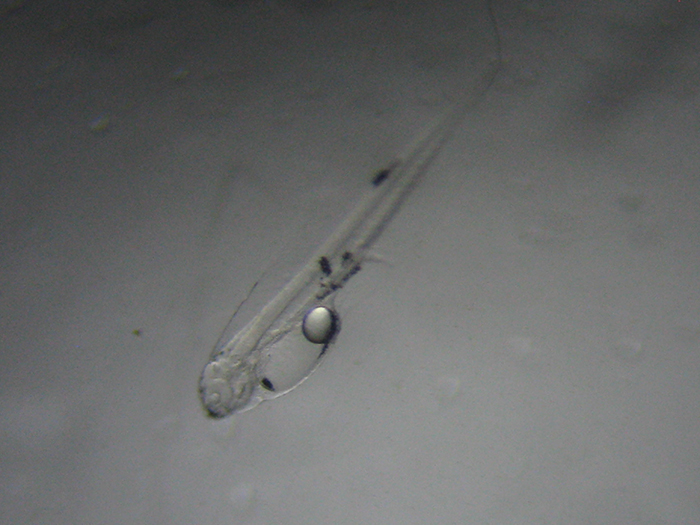
Centropyge bispinosa at day 2. Photo by Kathy Leahy.
The eggs that Tom gave me had already hatched in the transport bag, so I carefully drip acclimated them to my water and added them to the tub. They largely survived the transition, and once they had matured enough to hunt prey, began to thrive on my daily additions of all the Parvocalanus nauplii I could filter from my cultures. Day after day, I sampled larvae by scooping one out in a small cup and looking at it under my dissecting microscope. At 3 days, I saw full guts, and at 5 days, the formation of blood vessels, a developmental milestone that Frank Baensch described as an indication that they were getting the nutrition they needed, and that they might live.
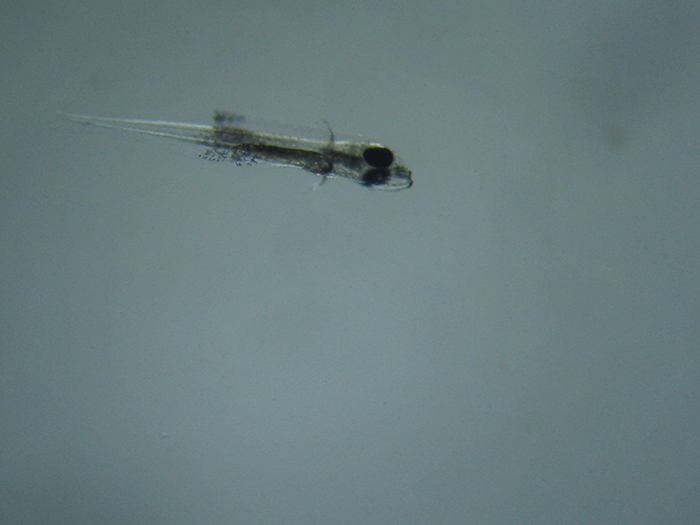
Centropyge bispinosa at day 4. Photo by Kathy Leahy.

Centropyge bispinosa at day 8. Photo by Kathy Leahy.
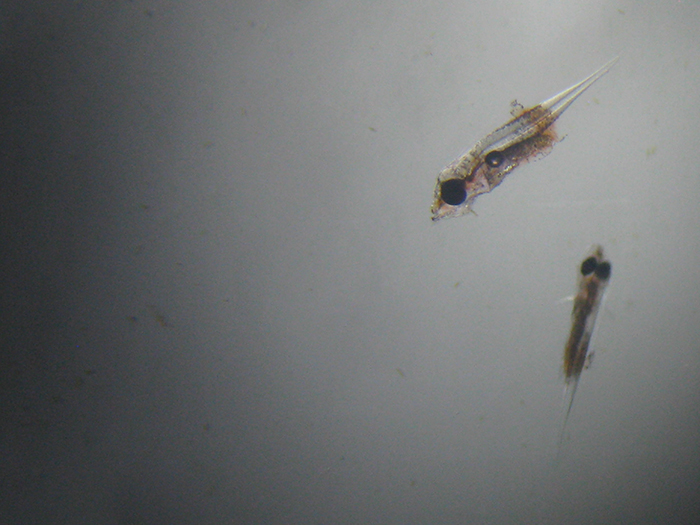
Centropyge bispinosa at day 8. Photo by Kathy Leahy.
And they lived, mostly. I noticed some decrease in numbers of larvae around day 10, but, on day 13, I sampled them twice. In the morning I saw a well developed, somewhat laterally compressed and rounded body, and in the evening, I saw the same with one important detail. The spine, which is visible through the transparent body, was beginning to abruptly curve up at the tail, indicating flexion, another developmental milestone that was not evident in my previous run, even at day 19. I was, again, thrilled!
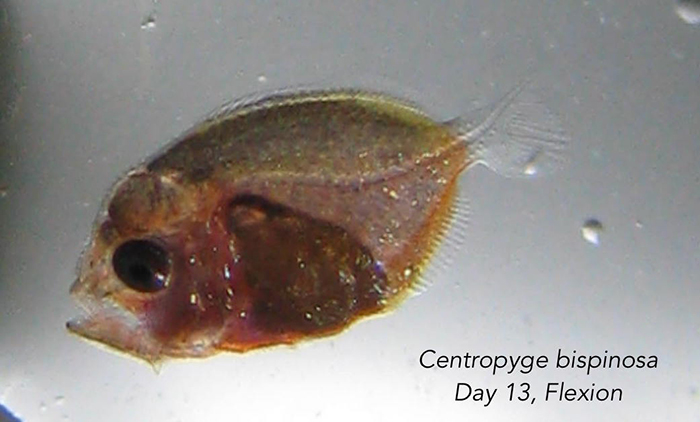
Centropyge bispinosa at day 13. Photo by Kathy Leahy.
Flexion is a major transformation in the life of larvae, and I’ve heard it described as the first metamorphosis. Most of the larvae did not survive it, but the ones that did, continued to thrive and grow for the most part, though some losses occurred. I fed larger copepods, and the tiniest pellet food available, without a clue if they were able to eat it. It’s hard to see what is going on in a black round tub.
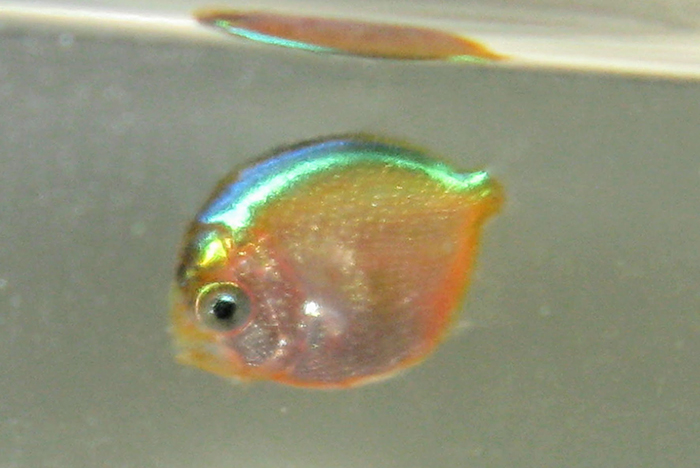
Centropyge bispinosa at day 25. Photo by Kathy Leahy.
At 30 days, they began to associate with small pieces of PVC that I had placed on the bottom of the vessel, and by day 31, I had 4 settled baby angelfish, still silver and round, like little pearlescent shirt buttons, swimming and scooting on the bottom of the tub.
A couple of weeks later, I moved them to the ten-gallon glass tank, mentioned above, and all but one continued to thrive. At last, I could see that they were indeed eating the pellets, and the tedious work of providing live feeds could, now, slow to maintaining the copepod cultures for the next attempt. The settled fish were still silver and round, and utterly delightful to watch. Soon their rear fins developed, their bodies became elongated and perciform, and blue pigments began to show near the tips of their new fins.
The adult coloration event described in the first paragraph of this article happened first to only one of the three fish at day 61 of their young life. It was not the largest fish of the three. The largest fish took another 30 days to achieve the same level of coloration and the smallest one transitioned a full two weeks after that. I have no idea why adult color development occurred over such a wide temporal range, or what the age of adult coloration is for wild Centropyge bispinosa in the beautiful ocean. Andy describes this long period after physical settlement as the brutal silver stage. I suppose one must have patience to do this job.
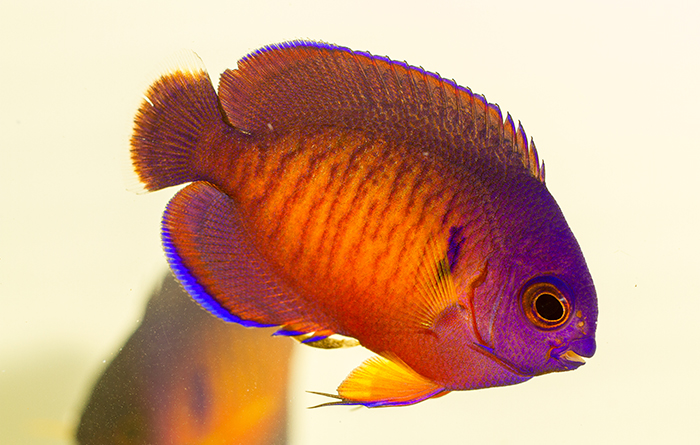
Centropyge bispinosa. Photo by Gary Parr.
With all the breakthroughs in raising new species that we have seen this year (see Tal Sweet’s article in Nov/Dec 2016 Coral), I really think that 2015 and 2016 are the years that we are first seeing an acceleration of what will be accomplished in marine ornamental fish breeding. Fifteen years after Baensch raised the first Centropyge in the middle of the Pacific Ocean on Oahu, Hawaii, three little Centropyge bispinosa survived captive rearing efforts and continue to thrive in the middle of the North American continent, on cultured copepods, phytoplankton, and pellets. If I can raise these tiny larvae on cultured foods, one can dream of what else can be done in marine ornamental fish breeding, and one can imagine that anyone, with the drive to try, can raise any species. For anyone interested in this endeavor, today is a wonderful time in history to be alive.



0 Comments